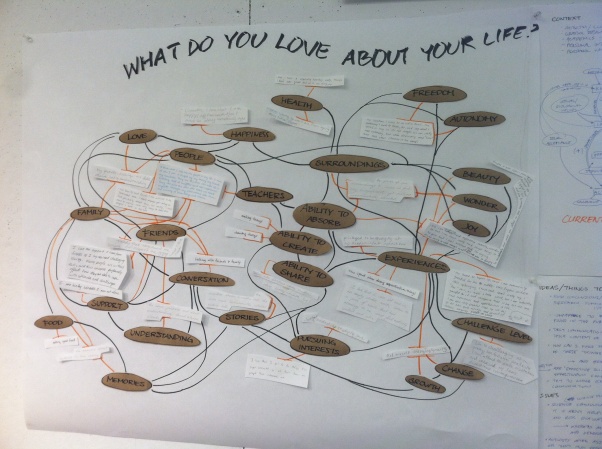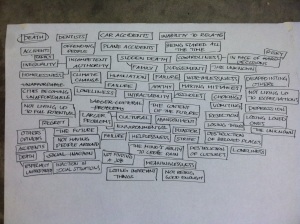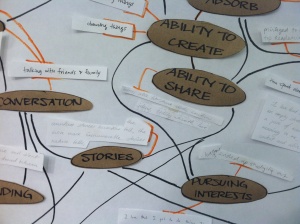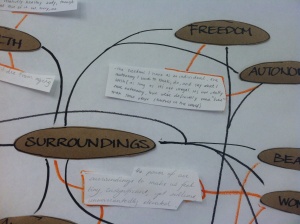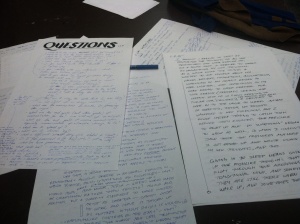“Your Brain on Improv”
It’s fascinating how much we have to go through just to get some glimpses at where and how the brain might do some of its creative production. What caught my attention in this talk was not the discrepancy between the areas that ‘lit up’ under different conditions in an fMRI scan, but rather the creativity behind the experimental design itself. Limb may not be a professional jazz musician, but he’s put together some pretty impressive improvisational techniques of his own.
Apart from that, it’s not surprising to hear that areas related to self-monitoring become less active and areas related to self-expression become more active during jazz or rap improvisation (as compared to a control of playing a memorized piece, which can often become partially driven by ‘muscle memory’). In my limited experience with piano improvisation, self-monitoring or any mental activity that places the focus externally can easily interrupt the interplay of the mind and the music.
I’m also curious as to why the researcher chose to make improvisation an analogue for other forms of creativity – his final unanswered questions seem to imply that he feels the study of brain reactions during improvisation could potentially create opportunities to ‘teach’ creativity. I feel that creativity is very ill-defined in this research – is it the output of original material synthesized within the brain, is it the output of material judged by society to be new and valuable, is it…? While I may not be in a position of expertise, I do feel that the concept of creativity is too often mysticized. Looking at blood flow in the brain may be one way of attaching it to physical reality, but identifying and developing different forms of creativity has a social and experiential basis as well. Humans are incessantly forming new neural connections, but they are also constantly seeking to fall back on old, efficient patterns. It may take a combination of scientific insight and self-awareness to understand the personal conditions that facilitate the formation of new patterns, and it is up to the individual and surrounding society to recognize which of those types of new patterns are most important to each of them.
“Woolf’s Darkness: Embracing the Inexplicable”
This article is the first I’ve read in a long time that has left me with a deeper sense of hope and peace. The idea that optimism and despair are both forms of certainty, but hope is an acknowledgement of uncertainty, is one that appeals to me (though it’s a statement that could use some qualifiers). We spend a lot of time trying to imagine our futures, or put a “visible shell around our souls” – amidst all that, there is a comfort in acknowledging that the inexplicable and unpredictable will always remain, and that that is okay.
Humanity is what we do in the face of uncertainty – there’s a wisp of a thought, and one of many overlapping possibilities.
The following passage (quoted from Woolf) caught my attention:
“Killing the Angel in the House was part of the occupation of the woman writer. The Angel was dead, what then remained? You may say that what remained was a simple and common object – a young woman in her bedroom with an inkpot. In other words, now that she had rid herself of falsehood, that young woman had only to be herself. Ah, but what is ‘herself’? I mean, what is a woman? I assure you, I do not know. I do not believe that you know.”
It was so refreshing to hear those last two sentences – in a couple lines, they lifted the pressure of needing to pin a definition or declaration on every action, every piece of self. The combined weight of our tags and crystallizations can provide a reassuring pressure, but they also make our movements restricted and labored. I don’t think it’s necessary to remove all those thought-constraints that make ourselves feel more solid, but it helped me to remember that we place them there to improve our own security, and that we can also lift and shape them, or flow out of them.
And a segue from that flow:
“Her demands for liberation for women were not merely so that they could do some of the institutional things men did (and women do now, too), but to have full freedom to roam, geographically and imaginatively.”
Woolf’s expanded definition of liberation was so simple, but it still gave me a bit of a mental shock nearly a century after she first wrote it. I know how to fight for institutional rights, but I don’t know where to find the gatekeeper for imaginative roaming. I actually think that my own interpretations of societal and personal restrictions form those walls – and that makes them harder than anything to tear down. Asking for that type of liberation is like asking to be freed from evolutionary and societal pressures, something that remains radical in any age (except perhaps to children, before they fully understand or internalize the latter).
This class is a group of eight women with a “room of our own,” and freedom to roam, but I’ve watched myself and my companions exposed to that freedom, and we’re terrified. We feel guilt, anxiety, a thousand other things. Many of us have been prompted in critique to step back, to try to “do nothing,” to siphon a little from that internal stream of thoughts and feelings – and many of us have encountered unsympathetic mental gatekeepers. In context of a lifetime, it is nothing to spend a week outside of our intentions, but what struck me is that we don’t even know how to do it. We want “focused roaming,” a paradoxical state; we want to be set free so that we can get as quickly as possible to the next station, the next product, the next goal. True imaginative liberation has led to many unintended insights (that in a more focused time can be directed toward goals), but conflicted and tentative pacing seems to lead mainly to mental anguish.
I feel oddly at peace writing this – perhaps the interpretation isn’t one Woolf intended, but I got something out of thinking those thoughts and writing those words. The not-knowing is okay because we have the freedom to create our own paths within it.
